Finance Assignment: Time Value of Money, Risk, and Return Analysis
VerifiedAdded on 2023/01/19
|8
|1768
|82
Homework Assignment
AI Summary
This finance assignment addresses key concepts in finance, including time value of money and bond valuation, alongside a risk and return analysis. The assignment calculates present values, revenue growth, and effective annual rates of interest. It determines quarterly loan payments, yield to maturity, and coupon payments for bonds. Furthermore, it applies the Capital Asset Pricing Model (CAPM) to assess the required rate of return for a company, constructs a portfolio, and evaluates investment projects considering risk and return metrics. The analysis utilizes data from S&P Capital IQ and includes calculations for beta, return on market, and portfolio weights to determine the overall performance and risk profile of investments, offering comprehensive insights into financial decision-making.
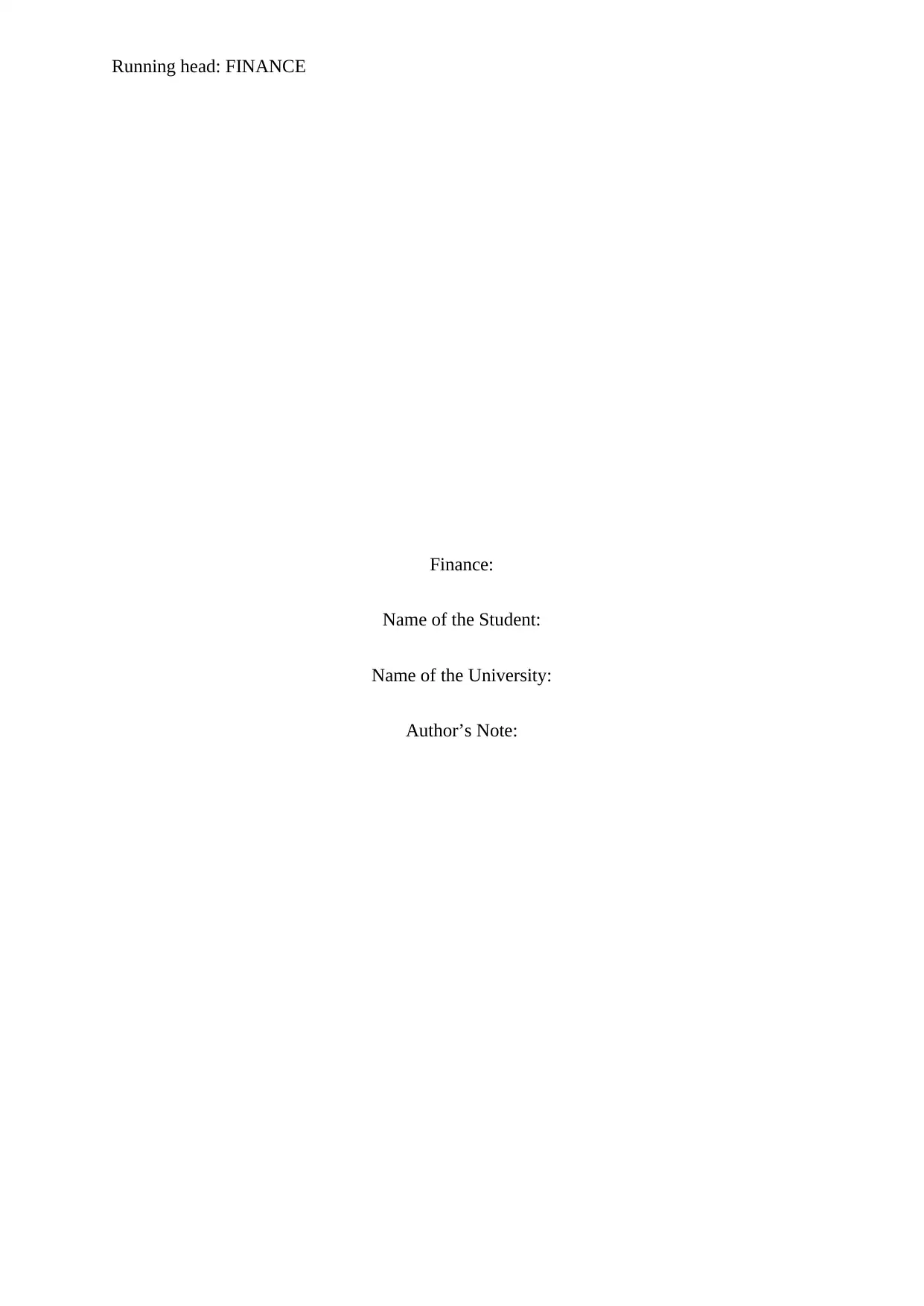
Running head: FINANCE
Finance:
Name of the Student:
Name of the University:
Author’s Note:
Finance:
Name of the Student:
Name of the University:
Author’s Note:
Paraphrase This Document
Need a fresh take? Get an instant paraphrase of this document with our AI Paraphraser

1FINANCE
Table of Contents
Question 1..................................................................................................................................2
Question 2..................................................................................................................................4
Question 3..................................................................................................................................5
References..................................................................................................................................7
Table of Contents
Question 1..................................................................................................................................2
Question 2..................................................................................................................................4
Question 3..................................................................................................................................5
References..................................................................................................................................7
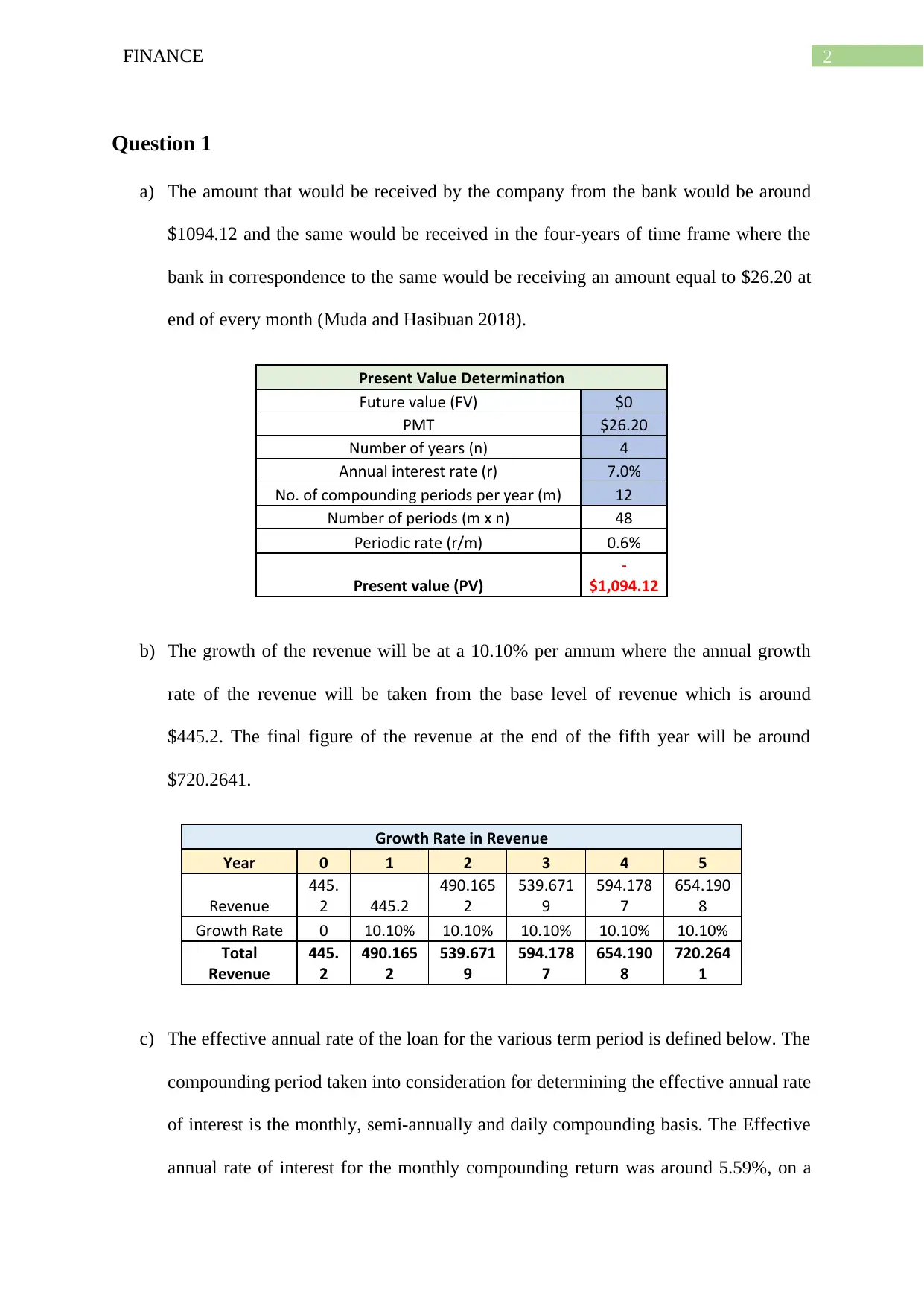
2FINANCE
Question 1
a) The amount that would be received by the company from the bank would be around
$1094.12 and the same would be received in the four-years of time frame where the
bank in correspondence to the same would be receiving an amount equal to $26.20 at
end of every month (Muda and Hasibuan 2018).
Present Value Determination
Future value (FV) $0
PMT $26.20
Number of years (n) 4
Annual interest rate (r) 7.0%
No. of compounding periods per year (m) 12
Number of periods (m x n) 48
Periodic rate (r/m) 0.6%
Present value (PV)
-
$1,094.12
b) The growth of the revenue will be at a 10.10% per annum where the annual growth
rate of the revenue will be taken from the base level of revenue which is around
$445.2. The final figure of the revenue at the end of the fifth year will be around
$720.2641.
Growth Rate in Revenue
Year 0 1 2 3 4 5
Revenue
445.
2 445.2
490.165
2
539.671
9
594.178
7
654.190
8
Growth Rate 0 10.10% 10.10% 10.10% 10.10% 10.10%
Total
Revenue
445.
2
490.165
2
539.671
9
594.178
7
654.190
8
720.264
1
c) The effective annual rate of the loan for the various term period is defined below. The
compounding period taken into consideration for determining the effective annual rate
of interest is the monthly, semi-annually and daily compounding basis. The Effective
annual rate of interest for the monthly compounding return was around 5.59%, on a
Question 1
a) The amount that would be received by the company from the bank would be around
$1094.12 and the same would be received in the four-years of time frame where the
bank in correspondence to the same would be receiving an amount equal to $26.20 at
end of every month (Muda and Hasibuan 2018).
Present Value Determination
Future value (FV) $0
PMT $26.20
Number of years (n) 4
Annual interest rate (r) 7.0%
No. of compounding periods per year (m) 12
Number of periods (m x n) 48
Periodic rate (r/m) 0.6%
Present value (PV)
-
$1,094.12
b) The growth of the revenue will be at a 10.10% per annum where the annual growth
rate of the revenue will be taken from the base level of revenue which is around
$445.2. The final figure of the revenue at the end of the fifth year will be around
$720.2641.
Growth Rate in Revenue
Year 0 1 2 3 4 5
Revenue
445.
2 445.2
490.165
2
539.671
9
594.178
7
654.190
8
Growth Rate 0 10.10% 10.10% 10.10% 10.10% 10.10%
Total
Revenue
445.
2
490.165
2
539.671
9
594.178
7
654.190
8
720.264
1
c) The effective annual rate of the loan for the various term period is defined below. The
compounding period taken into consideration for determining the effective annual rate
of interest is the monthly, semi-annually and daily compounding basis. The Effective
annual rate of interest for the monthly compounding return was around 5.59%, on a
⊘ This is a preview!⊘
Do you want full access?
Subscribe today to unlock all pages.

Trusted by 1+ million students worldwide
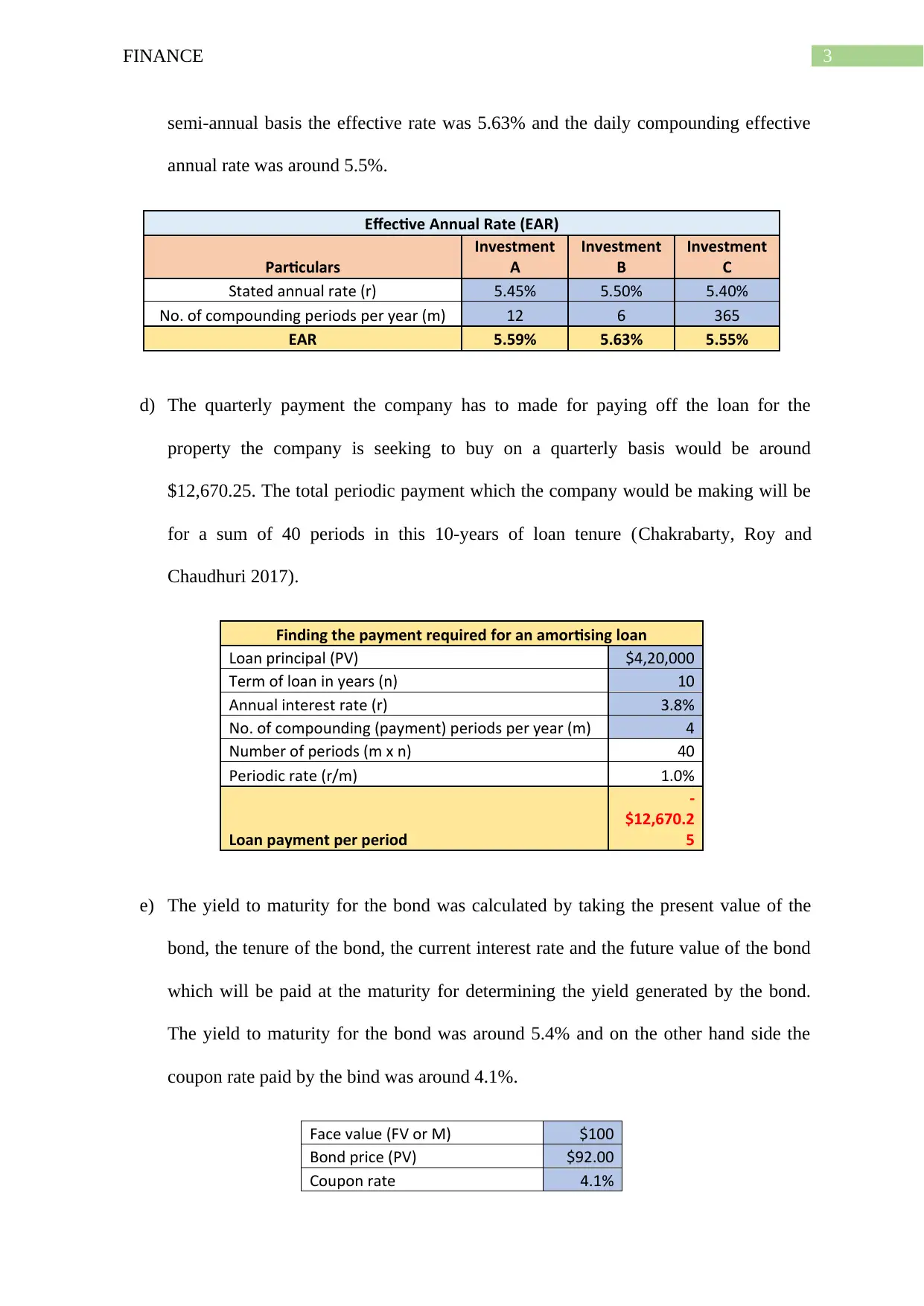
3FINANCE
semi-annual basis the effective rate was 5.63% and the daily compounding effective
annual rate was around 5.5%.
Effective Annual Rate (EAR)
Particulars
Investment
A
Investment
B
Investment
C
Stated annual rate (r) 5.45% 5.50% 5.40%
No. of compounding periods per year (m) 12 6 365
EAR 5.59% 5.63% 5.55%
d) The quarterly payment the company has to made for paying off the loan for the
property the company is seeking to buy on a quarterly basis would be around
$12,670.25. The total periodic payment which the company would be making will be
for a sum of 40 periods in this 10-years of loan tenure (Chakrabarty, Roy and
Chaudhuri 2017).
Finding the payment required for an amortising loan
Loan principal (PV) $4,20,000
Term of loan in years (n) 10
Annual interest rate (r) 3.8%
No. of compounding (payment) periods per year (m) 4
Number of periods (m x n) 40
Periodic rate (r/m) 1.0%
Loan payment per period
-
$12,670.2
5
e) The yield to maturity for the bond was calculated by taking the present value of the
bond, the tenure of the bond, the current interest rate and the future value of the bond
which will be paid at the maturity for determining the yield generated by the bond.
The yield to maturity for the bond was around 5.4% and on the other hand side the
coupon rate paid by the bind was around 4.1%.
Face value (FV or M) $100
Bond price (PV) $92.00
Coupon rate 4.1%
semi-annual basis the effective rate was 5.63% and the daily compounding effective
annual rate was around 5.5%.
Effective Annual Rate (EAR)
Particulars
Investment
A
Investment
B
Investment
C
Stated annual rate (r) 5.45% 5.50% 5.40%
No. of compounding periods per year (m) 12 6 365
EAR 5.59% 5.63% 5.55%
d) The quarterly payment the company has to made for paying off the loan for the
property the company is seeking to buy on a quarterly basis would be around
$12,670.25. The total periodic payment which the company would be making will be
for a sum of 40 periods in this 10-years of loan tenure (Chakrabarty, Roy and
Chaudhuri 2017).
Finding the payment required for an amortising loan
Loan principal (PV) $4,20,000
Term of loan in years (n) 10
Annual interest rate (r) 3.8%
No. of compounding (payment) periods per year (m) 4
Number of periods (m x n) 40
Periodic rate (r/m) 1.0%
Loan payment per period
-
$12,670.2
5
e) The yield to maturity for the bond was calculated by taking the present value of the
bond, the tenure of the bond, the current interest rate and the future value of the bond
which will be paid at the maturity for determining the yield generated by the bond.
The yield to maturity for the bond was around 5.4% and on the other hand side the
coupon rate paid by the bind was around 4.1%.
Face value (FV or M) $100
Bond price (PV) $92.00
Coupon rate 4.1%
Paraphrase This Document
Need a fresh take? Get an instant paraphrase of this document with our AI Paraphraser
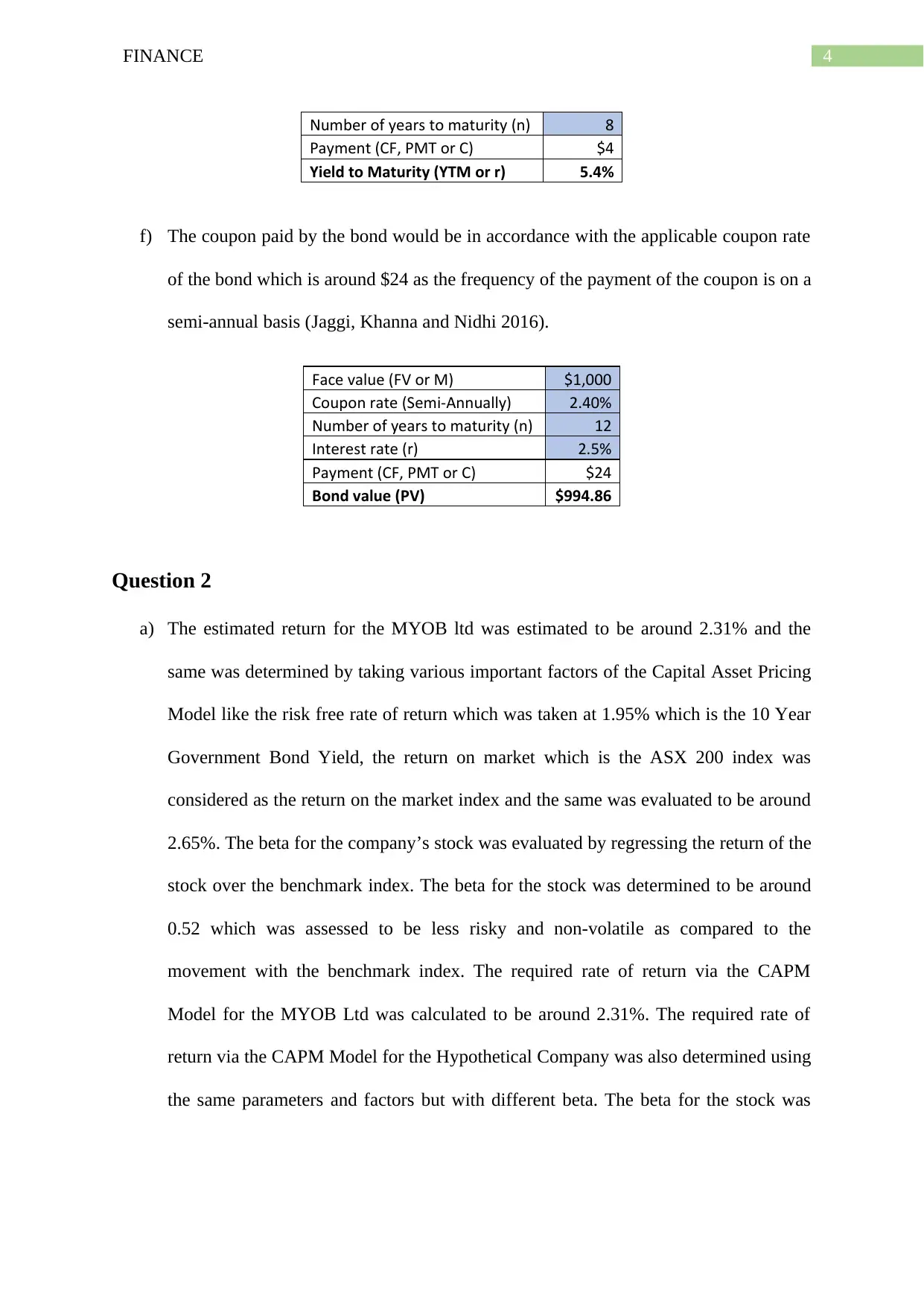
4FINANCE
Number of years to maturity (n) 8
Payment (CF, PMT or C) $4
Yield to Maturity (YTM or r) 5.4%
f) The coupon paid by the bond would be in accordance with the applicable coupon rate
of the bond which is around $24 as the frequency of the payment of the coupon is on a
semi-annual basis (Jaggi, Khanna and Nidhi 2016).
Face value (FV or M) $1,000
Coupon rate (Semi-Annually) 2.40%
Number of years to maturity (n) 12
Interest rate (r) 2.5%
Payment (CF, PMT or C) $24
Bond value (PV) $994.86
Question 2
a) The estimated return for the MYOB ltd was estimated to be around 2.31% and the
same was determined by taking various important factors of the Capital Asset Pricing
Model like the risk free rate of return which was taken at 1.95% which is the 10 Year
Government Bond Yield, the return on market which is the ASX 200 index was
considered as the return on the market index and the same was evaluated to be around
2.65%. The beta for the company’s stock was evaluated by regressing the return of the
stock over the benchmark index. The beta for the stock was determined to be around
0.52 which was assessed to be less risky and non-volatile as compared to the
movement with the benchmark index. The required rate of return via the CAPM
Model for the MYOB Ltd was calculated to be around 2.31%. The required rate of
return via the CAPM Model for the Hypothetical Company was also determined using
the same parameters and factors but with different beta. The beta for the stock was
Number of years to maturity (n) 8
Payment (CF, PMT or C) $4
Yield to Maturity (YTM or r) 5.4%
f) The coupon paid by the bond would be in accordance with the applicable coupon rate
of the bond which is around $24 as the frequency of the payment of the coupon is on a
semi-annual basis (Jaggi, Khanna and Nidhi 2016).
Face value (FV or M) $1,000
Coupon rate (Semi-Annually) 2.40%
Number of years to maturity (n) 12
Interest rate (r) 2.5%
Payment (CF, PMT or C) $24
Bond value (PV) $994.86
Question 2
a) The estimated return for the MYOB ltd was estimated to be around 2.31% and the
same was determined by taking various important factors of the Capital Asset Pricing
Model like the risk free rate of return which was taken at 1.95% which is the 10 Year
Government Bond Yield, the return on market which is the ASX 200 index was
considered as the return on the market index and the same was evaluated to be around
2.65%. The beta for the company’s stock was evaluated by regressing the return of the
stock over the benchmark index. The beta for the stock was determined to be around
0.52 which was assessed to be less risky and non-volatile as compared to the
movement with the benchmark index. The required rate of return via the CAPM
Model for the MYOB Ltd was calculated to be around 2.31%. The required rate of
return via the CAPM Model for the Hypothetical Company was also determined using
the same parameters and factors but with different beta. The beta for the stock was
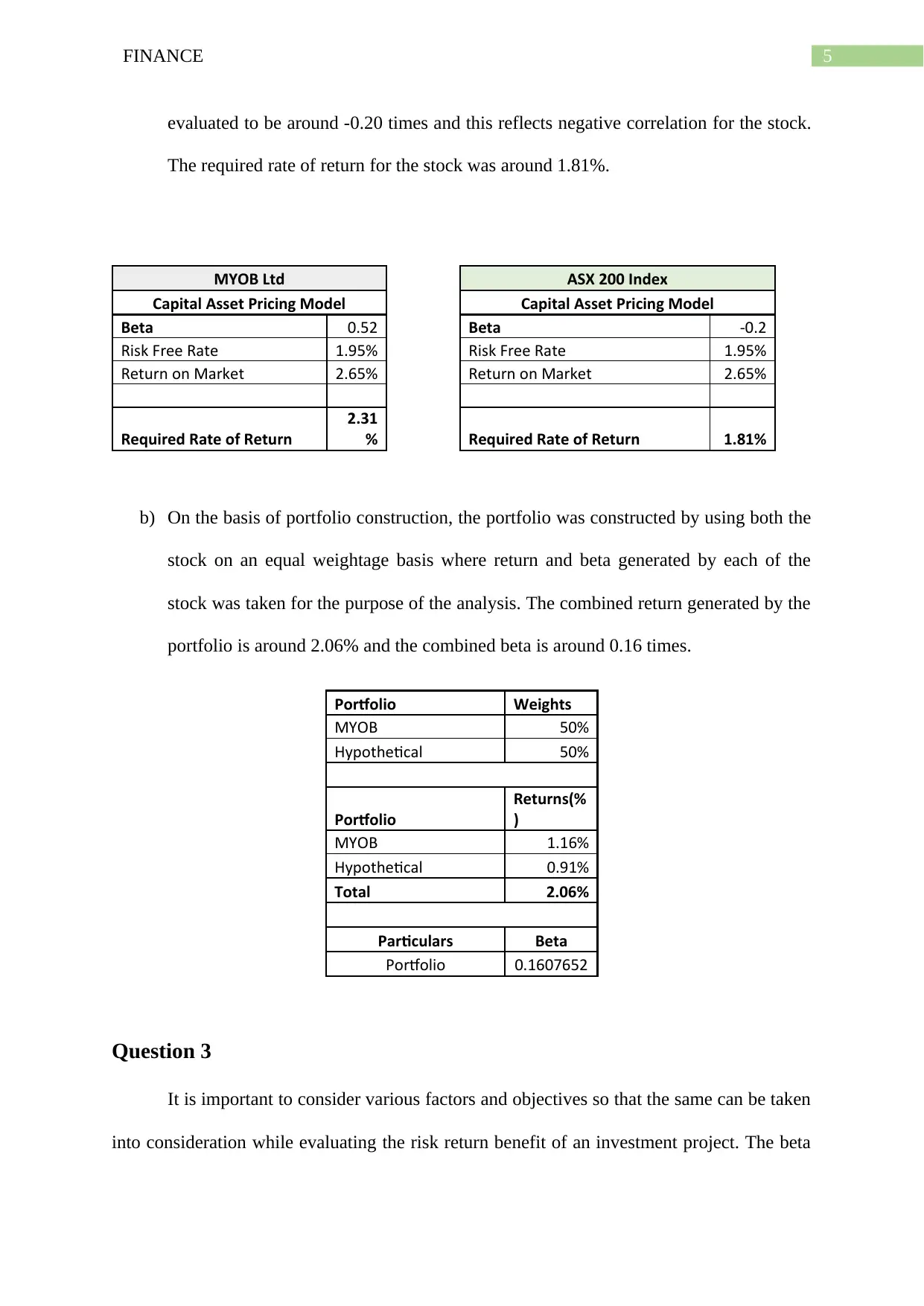
5FINANCE
evaluated to be around -0.20 times and this reflects negative correlation for the stock.
The required rate of return for the stock was around 1.81%.
MYOB Ltd ASX 200 Index
Capital Asset Pricing Model Capital Asset Pricing Model
Beta 0.52 Beta -0.2
Risk Free Rate 1.95% Risk Free Rate 1.95%
Return on Market 2.65% Return on Market 2.65%
Required Rate of Return
2.31
% Required Rate of Return 1.81%
b) On the basis of portfolio construction, the portfolio was constructed by using both the
stock on an equal weightage basis where return and beta generated by each of the
stock was taken for the purpose of the analysis. The combined return generated by the
portfolio is around 2.06% and the combined beta is around 0.16 times.
Portfolio Weights
MYOB 50%
Hypothetical 50%
Portfolio
Returns(%
)
MYOB 1.16%
Hypothetical 0.91%
Total 2.06%
Particulars Beta
Portfolio 0.1607652
Question 3
It is important to consider various factors and objectives so that the same can be taken
into consideration while evaluating the risk return benefit of an investment project. The beta
evaluated to be around -0.20 times and this reflects negative correlation for the stock.
The required rate of return for the stock was around 1.81%.
MYOB Ltd ASX 200 Index
Capital Asset Pricing Model Capital Asset Pricing Model
Beta 0.52 Beta -0.2
Risk Free Rate 1.95% Risk Free Rate 1.95%
Return on Market 2.65% Return on Market 2.65%
Required Rate of Return
2.31
% Required Rate of Return 1.81%
b) On the basis of portfolio construction, the portfolio was constructed by using both the
stock on an equal weightage basis where return and beta generated by each of the
stock was taken for the purpose of the analysis. The combined return generated by the
portfolio is around 2.06% and the combined beta is around 0.16 times.
Portfolio Weights
MYOB 50%
Hypothetical 50%
Portfolio
Returns(%
)
MYOB 1.16%
Hypothetical 0.91%
Total 2.06%
Particulars Beta
Portfolio 0.1607652
Question 3
It is important to consider various factors and objectives so that the same can be taken
into consideration while evaluating the risk return benefit of an investment project. The beta
⊘ This is a preview!⊘
Do you want full access?
Subscribe today to unlock all pages.

Trusted by 1+ million students worldwide
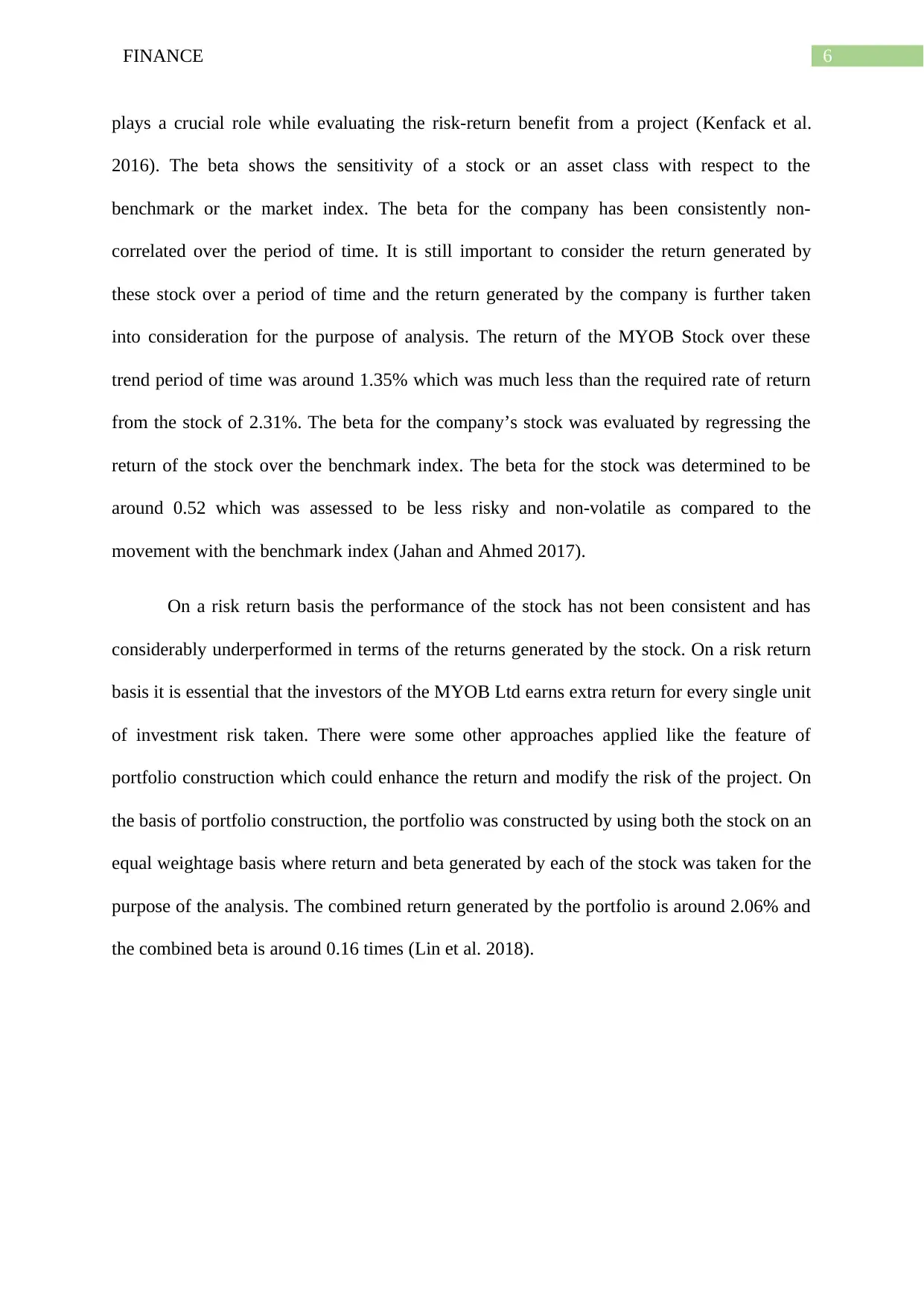
6FINANCE
plays a crucial role while evaluating the risk-return benefit from a project (Kenfack et al.
2016). The beta shows the sensitivity of a stock or an asset class with respect to the
benchmark or the market index. The beta for the company has been consistently non-
correlated over the period of time. It is still important to consider the return generated by
these stock over a period of time and the return generated by the company is further taken
into consideration for the purpose of analysis. The return of the MYOB Stock over these
trend period of time was around 1.35% which was much less than the required rate of return
from the stock of 2.31%. The beta for the company’s stock was evaluated by regressing the
return of the stock over the benchmark index. The beta for the stock was determined to be
around 0.52 which was assessed to be less risky and non-volatile as compared to the
movement with the benchmark index (Jahan and Ahmed 2017).
On a risk return basis the performance of the stock has not been consistent and has
considerably underperformed in terms of the returns generated by the stock. On a risk return
basis it is essential that the investors of the MYOB Ltd earns extra return for every single unit
of investment risk taken. There were some other approaches applied like the feature of
portfolio construction which could enhance the return and modify the risk of the project. On
the basis of portfolio construction, the portfolio was constructed by using both the stock on an
equal weightage basis where return and beta generated by each of the stock was taken for the
purpose of the analysis. The combined return generated by the portfolio is around 2.06% and
the combined beta is around 0.16 times (Lin et al. 2018).
plays a crucial role while evaluating the risk-return benefit from a project (Kenfack et al.
2016). The beta shows the sensitivity of a stock or an asset class with respect to the
benchmark or the market index. The beta for the company has been consistently non-
correlated over the period of time. It is still important to consider the return generated by
these stock over a period of time and the return generated by the company is further taken
into consideration for the purpose of analysis. The return of the MYOB Stock over these
trend period of time was around 1.35% which was much less than the required rate of return
from the stock of 2.31%. The beta for the company’s stock was evaluated by regressing the
return of the stock over the benchmark index. The beta for the stock was determined to be
around 0.52 which was assessed to be less risky and non-volatile as compared to the
movement with the benchmark index (Jahan and Ahmed 2017).
On a risk return basis the performance of the stock has not been consistent and has
considerably underperformed in terms of the returns generated by the stock. On a risk return
basis it is essential that the investors of the MYOB Ltd earns extra return for every single unit
of investment risk taken. There were some other approaches applied like the feature of
portfolio construction which could enhance the return and modify the risk of the project. On
the basis of portfolio construction, the portfolio was constructed by using both the stock on an
equal weightage basis where return and beta generated by each of the stock was taken for the
purpose of the analysis. The combined return generated by the portfolio is around 2.06% and
the combined beta is around 0.16 times (Lin et al. 2018).
Paraphrase This Document
Need a fresh take? Get an instant paraphrase of this document with our AI Paraphraser
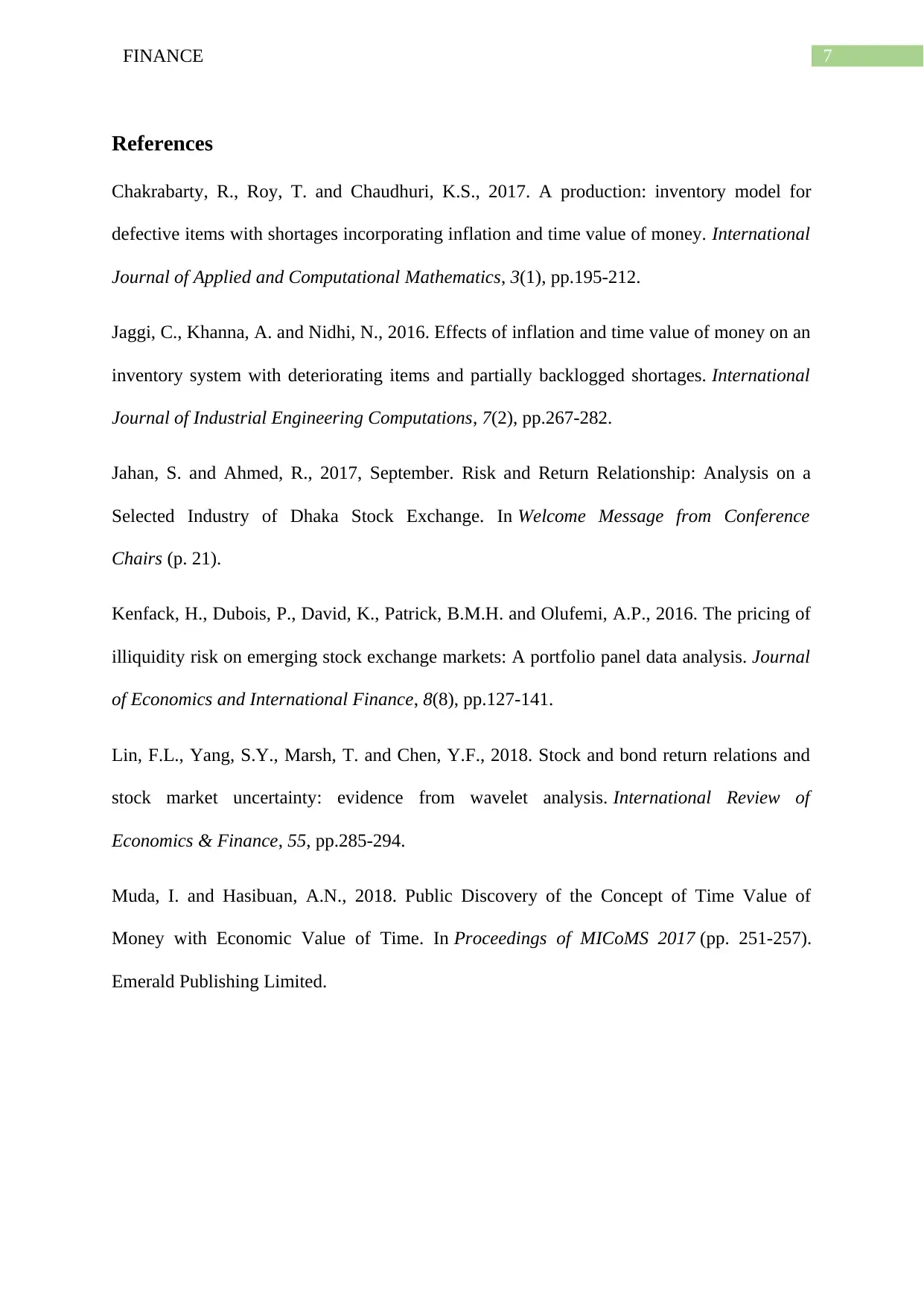
7FINANCE
References
Chakrabarty, R., Roy, T. and Chaudhuri, K.S., 2017. A production: inventory model for
defective items with shortages incorporating inflation and time value of money. International
Journal of Applied and Computational Mathematics, 3(1), pp.195-212.
Jaggi, C., Khanna, A. and Nidhi, N., 2016. Effects of inflation and time value of money on an
inventory system with deteriorating items and partially backlogged shortages. International
Journal of Industrial Engineering Computations, 7(2), pp.267-282.
Jahan, S. and Ahmed, R., 2017, September. Risk and Return Relationship: Analysis on a
Selected Industry of Dhaka Stock Exchange. In Welcome Message from Conference
Chairs (p. 21).
Kenfack, H., Dubois, P., David, K., Patrick, B.M.H. and Olufemi, A.P., 2016. The pricing of
illiquidity risk on emerging stock exchange markets: A portfolio panel data analysis. Journal
of Economics and International Finance, 8(8), pp.127-141.
Lin, F.L., Yang, S.Y., Marsh, T. and Chen, Y.F., 2018. Stock and bond return relations and
stock market uncertainty: evidence from wavelet analysis. International Review of
Economics & Finance, 55, pp.285-294.
Muda, I. and Hasibuan, A.N., 2018. Public Discovery of the Concept of Time Value of
Money with Economic Value of Time. In Proceedings of MICoMS 2017 (pp. 251-257).
Emerald Publishing Limited.
References
Chakrabarty, R., Roy, T. and Chaudhuri, K.S., 2017. A production: inventory model for
defective items with shortages incorporating inflation and time value of money. International
Journal of Applied and Computational Mathematics, 3(1), pp.195-212.
Jaggi, C., Khanna, A. and Nidhi, N., 2016. Effects of inflation and time value of money on an
inventory system with deteriorating items and partially backlogged shortages. International
Journal of Industrial Engineering Computations, 7(2), pp.267-282.
Jahan, S. and Ahmed, R., 2017, September. Risk and Return Relationship: Analysis on a
Selected Industry of Dhaka Stock Exchange. In Welcome Message from Conference
Chairs (p. 21).
Kenfack, H., Dubois, P., David, K., Patrick, B.M.H. and Olufemi, A.P., 2016. The pricing of
illiquidity risk on emerging stock exchange markets: A portfolio panel data analysis. Journal
of Economics and International Finance, 8(8), pp.127-141.
Lin, F.L., Yang, S.Y., Marsh, T. and Chen, Y.F., 2018. Stock and bond return relations and
stock market uncertainty: evidence from wavelet analysis. International Review of
Economics & Finance, 55, pp.285-294.
Muda, I. and Hasibuan, A.N., 2018. Public Discovery of the Concept of Time Value of
Money with Economic Value of Time. In Proceedings of MICoMS 2017 (pp. 251-257).
Emerald Publishing Limited.
1 out of 8
Related Documents
Your All-in-One AI-Powered Toolkit for Academic Success.
+13062052269
info@desklib.com
Available 24*7 on WhatsApp / Email
![[object Object]](/_next/static/media/star-bottom.7253800d.svg)
Unlock your academic potential
Copyright © 2020–2025 A2Z Services. All Rights Reserved. Developed and managed by ZUCOL.




